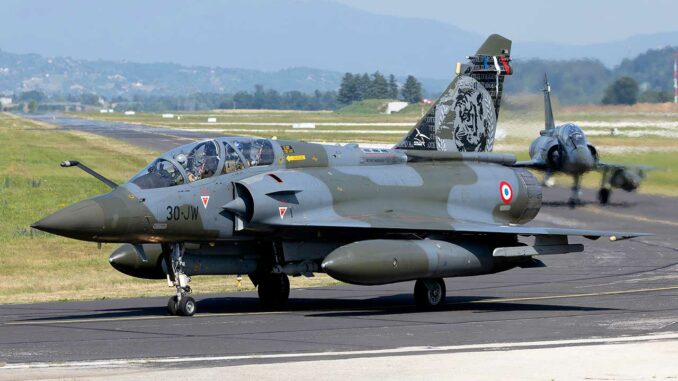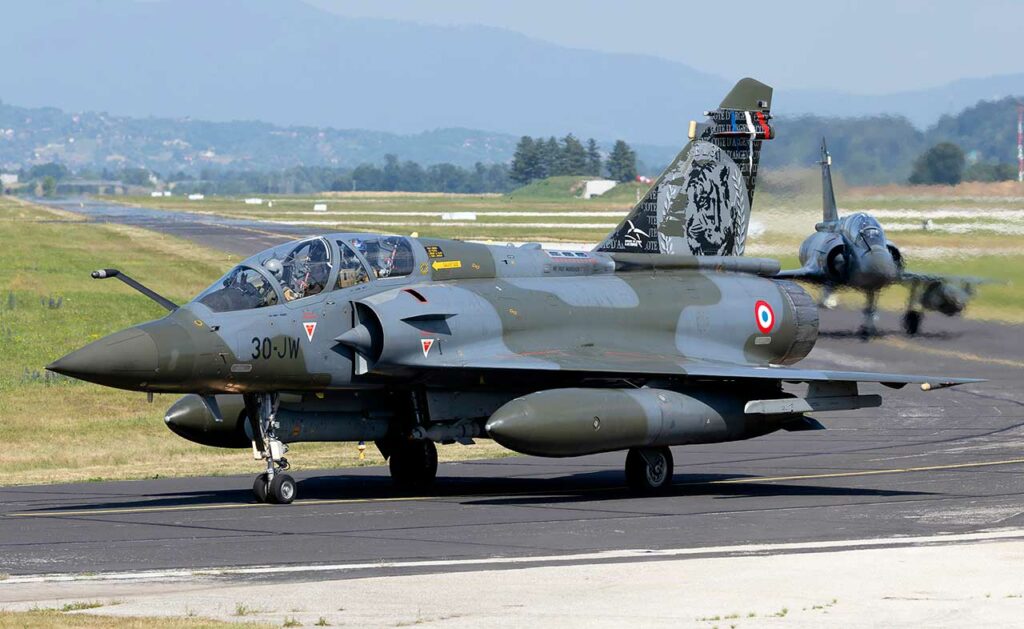
The French Air and Space Force is validating a rapid deployment system for its Mirage 2000D aircraft at Metz-Nancy-Lorraine, with training linked to BASEX and designed for high-intensity scenarios.
Summary
The Air and Space Force has trained in the implementation of its FRA-ACE concept at the civilian airport of Lorraine Aéroport (Metz-Nancy-Lorraine). The objective was to verify the ability to rapidly disperse and deploy combat aircraft, in this case Mirage 2000Ds, from a non-military infrastructure, with a reduced logistical footprint and close coordination of support and protection functions. The exercise, based on the BASEX cycle, simulated realistic threats (basic defense, anti-drone, alert, CBRN), while generating operational flights from a 3,050 m (10,006 ft) civilian runway. The choice of the Mirage 2000D RMV—modernized with TALIOS pods, data links, and new weapons—highlights the logic: to produce sorties in a dispersed context, at short notice, with reduced teams and allied cross-servicing. The training program included up to six sorties per day, without night flights, validating procedures that can be replicated in mainland France and abroad for high-intensity scenarios.
The maneuver and its objectives
From September 22 to 26, 2025, the AAE conducted training at the Metz-Nancy-Lorraine civil airport, combining the BASEX exercise (basic protection and defense) with a FRA-ACE phase deploying several Mirage 2000Ds from the 3rd Fighter Wing. The schedule included a ramp-up with defense activities, anti-drone operations, alert procedures, and explosives management, while generating missions from the civilian site. Local authorities announced a limit of six sorties per day between September 23 and 25, with no night flights, under the coordination of the AAE Territorial Command. This combination of “basic defense + dispersion” aims to test the continuity of air activity despite a main base being unavailable or under threat.
The concept and its roots
The FRA-ACE is the French adaptation of Agile Combat Employment: a “proactive and reactive maneuver plan within the time constraints imposed by the threat” designed to increase air force survivability and power. In France, it is based on the MORANE (Mise en Œuvre Réactive de l’Arme Aérienne) concept, which formalizes the dispersion of aircraft and support to civilian or military airfields, with “essential” technical packages and shared resources. MORANE has been tested in Europe (Romania, Croatia, Sweden) with short deployments, short notice, and the use of host cross-servicing (oxygen, nitrogen, handling equipment). Official documents (National Assembly, doctrine, and feedback) support this logic of resilience.
The choice of civilian infrastructure
Lorraine Airport offers a 3,050 m (10,006 ft) runway, 45 m wide, ILS Cat. III and a 7,000 m² terminal, sized for commercial and cargo traffic. This configuration facilitates the reception of combat aircraft and support convoys while guaranteeing performance, refueling, and clearance margins. For the AAE, the challenge is twofold: to validate the operational interface with a civilian platform (slots, security, pyrotechnic perimeters, ATC) and to verify the sustainability of mission generation “from any compatible terrain” in mainland France.
The Mirage 2000D RMV aircraft at the heart of the system
The modernized Mirage 2000D RMV will remain in service beyond 2030 and incorporates useful components for dispersal: TALIOS pod (reconnaissance/identification/laser), data links (including Link 16), GBU-49/48/50 guided weapons, AASM, BAT-120LG light ammunition, enhanced self-protection (additional decoys via a specific ventral tank), and air-to-air self-defense capabilities (MICA NG IR) replacing the Magic II. The addition of the 30 mm cannon pod (CC422) offers a close support option on rough terrain. At BA 133, a fleet of 50 aircraft, to be modernized by the end of 2025, will serve as the basis for these experiments, with the aim of maintaining strike capability from dispersed sites with limited crews and resources.

Logistics and protection in “reduced footprint” mode
The core of the operational agility approach lies in the simplicity of support: pre-palletized technical packages, reduced personnel, transport by A400M, and sharing of resources with the host (aviation fuel, vehicles). Feedback from the MORANE deployment in Romania mentions a load of around 4 tons for 20 m³, divided into batches (systems, detachment, CBRN), and ten sorties totaling more than fifteen hours of flight time in one week with a detachment of around thirty airmen. At Metz-Nancy-Lorraine, the “basic defense” dimension of BASEX made it possible to simultaneously practice perimeter protection (anti-drones, EOD, access control), a prerequisite for operating from a civilian airfield.
Expected efficiency: pace, deadlines, and coordination
On civilian ground, efficiency is measured primarily by the rate of flight generation and the maintenance of ATC slots. The announced ceiling of six sorties per day at Metz-Nancy-Lorraine is compatible with a light Mirage 2000D detachment, subject to good weather conditions and close coordination with the platform. Turnaround procedures are based on checklists adapted to reduced support (weapons under control, fuel, oxygen, visual inspections), while ground traffic and coactivity with civil traffic are regulated by marked routes and temporary pyrotechnic zones. In the event of an alert or incident, the decision-making chain (CTAAE, operational command) immediately arbitrates between aviation safety, security, and maintaining operational effort.
Limitations and points of attention
Dispersion does not come without a cost. The reduction in local stock (parts, tools) requires precise management of replenishment and prioritization of breakdowns. Civil/military co-activity requires robust procedures for deconfliction, communication (frequencies, phraseology, data link), and security (ammunition, perimeters). Maintaining the performance of the Mirage 2000D RMV—in particular the availability of the TALIOS pod and guided kits—is essential to the quality of the effects that can be generated “from roaming.” Finally, the AAE must ensure that teams are trained in cross-services and “field” troubleshooting to avoid technical attrition in dispersed postures. These constraints are addressed by the FRA-ACE architecture, which favors short, reproducible deployments that can be integrated into NATO plans.
The capability perspective
The ramp-up of FRA-ACE prepares the AAE for A2/AD environments where bases are highly vulnerable. It promotes NATO interoperability, logistical pooling, and a more “nomadic” posture for air assets. In the short term, the 3rd Wing will be able to capitalize on the experience of Metz-Nancy-Lorraine to strengthen its dispersion patterns in mainland France and abroad. In the medium term, extending these procedures to other fleets, integrating ISR assets and diversified precision munitions, and making greater use of networked tactical data should consolidate this agility. The exercise also serves as a full-scale test for civil authorities, demonstrating that a regional airport can, if necessary, serve as a military staging area without paralyzing its activity.
War Wings Daily is an independant magazine.